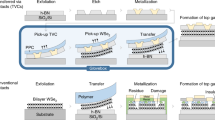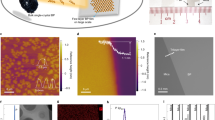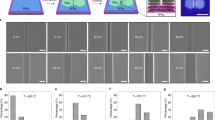Abstract
Two-dimensional (2D) semiconductors can potentially be used to create scaled electronic devices. However, for a number of promising 2D materials—such as black phosphorus and germanium arsenide—the fabrication of monolayer transistors is challenging and is limited by the difficulties in forming robust electrical contacts with the delicate 2D materials. Here, we report the fabrication of monolayer black phosphorus and germanium arsenide transistors with three-dimensional raised contacts using a van der Waals peeling technique. Through layer-by-layer mechanical peeling, the channel region of a multilayer black phosphorus transistor can be gradually reduced to monolayer thickness without degrading its delicate lattice and while retaining a multilayer contact region. Using the technique, we measure the electrical properties of the same 2D transistor with different channel thicknesses. We find that the carrier mobility of black phosphorus drops sharply when reducing body thickness, behaving more like a conventional bulk semiconductor rather than a pure van der Waals semiconductor.
This is a preview of subscription content, access via your institution
Access options
Access Nature and 54 other Nature Portfolio journals
Get Nature+, our best-value online-access subscription
$29.99 / 30 days
cancel any time
Subscribe to this journal
Receive 12 digital issues and online access to articles
$119.00 per year
only $9.92 per issue
Buy this article
- Purchase on Springer Link
- Instant access to full article PDF
Prices may be subject to local taxes which are calculated during checkout




Similar content being viewed by others
Data availability
The data that support the findings of this study are available from the corresponding author upon reasonable request.
References
Wu, F. et al. Vertical MoS2 transistors with sub-1-nm gate lengths. Nature 603, 259–264 (2022).
Wu, R. et al. Bilayer tungsten diselenide transistors with on-state currents exceeding 1.5 milliamperes per micrometre. Nat. Electron. 5, 497–504 (2022).
Desai, S. B. et al. MoS2 transistors with 1-nanometer gate lengths. Science 354, 99–102 (2016).
Li, M. Y., Su, S. K., Wong, H. S. P. & Li, L. J. How 2D semiconductors could extend Moore’s law. Nature 567, 169–170 (2019).
Uchida, K. & Takagi, S.-I. Carrier scattering induced by thickness fluctuation of silicon-on-insulator film in ultrathin-body metal–oxide–semiconductor field-effect transistors. Appl. Phys. Lett. 82, 2916–2918 (2003).
Uchida, K. et al. Experimental study on carrier transport mechanism in ultrathin-body SOI n- and p-MOSFETs with SOI thickness less than 5 nm. In Digest. International Electron Devices Meeting, 47–50 (IEEE, 2002).
Liu, Y. et al. Promises and prospects of two-dimensional transistors. Nature 591, 43–53 (2021).
Liu, Y., Duan, X., Huang, Y. & Duan, X. Two-dimensional transistors beyond graphene and TMDCs. Chem. Soc. Rev. 47, 6388–6409 (2018).
Guo, J. et al. Few-layer GeAs field-effect transistors and infrared photodetectors. Adv. Mater. 30, 1705934 (2018).
Liu, H. et al. Phosphorene: an unexplored 2D semiconductor with a high hole mobility. ACS Nano 8, 4033–4041 (2014).
Li, L. et al. Direct observation of the layer-dependent electronic structure in phosphorene. Nat. Nanotechnol. 12, 21–25 (2017).
Wang, Y. et al. Van der Waals contacts between three-dimensional metals and two-dimensional semiconductors. Nature 568, 70–74 (2019).
Liu, L. et al. Transferred van der Waals metal electrodes for sub-1-nm MoS2 vertical transistors. Nat. Electron. 4, 342–347 (2021).
Li, W. et al. Realization of ultra-scaled MoS2 vertical diodes via double-side electrodes lamination. Nano Lett. 22, 4429–4436 (2022).
Liu, Y. et al. Approaching the Schottky-Mott limit in van der Waals metal-semiconductor junctions. Nature 557, 696–700 (2018).
Liu, Y., Huang, Y. & Duan, X. Van der Waals integration before and beyond two-dimensional materials. Nature 567, 323–333 (2019).
Jung, Y. et al. Transferred via contacts as a platform for ideal two-dimensional transistors. Nat. Electron. 2, 187–194 (2019).
Song, W. et al. High-resolution van der Waals stencil lithography for 2D transistors. Small 17, 2101209 (2021).
Gusmao, R., Sofer, Z. & Pumera, M. Black phosphorus rediscovered: from bulk material to monolayers. Angew. Chem. Int. Ed. 56, 8052–8072 (2017).
Kim, S. et al. Thickness-controlled black phosphorus tunnel field-effect transistor for low-power switches. Nat. Nanotechnol. 15, 203–206 (2020).
Choi, Y. K. et al. Ultrathin-body SOI MOSFET for deep-sub-tenth micron era. IEEE Electron Device Lett. 21, 254–255 (2000).
Kolahdouz, M. et al. Selective epitaxial growth with full control of pattern dependency behavior for pMOSFET structures. J. Electrochem. Soc. 156, H169–H171 (2009).
Hsiang-Jen, H. et al. Reduction of source/drain series resistance and its impact on device performance for PMOS transistors with raised Si1-x/Gex source/drain. IEEE Electron Device Lett. 21, 448–450 (2000).
Barraud, S. et al. Enhanced performance of P-FET omega-gate SoI nanowire with recessed-SiGe source-drain down to 13-nm gate length. IEEE Electron Device Lett. 34, 1103–1105 (2013).
Liu, Y. et al. Layer-by-layer thinning of MoS2 by plasma. ACS Nano 7, 4202–4209 (2013).
Lu, W. et al. Plasma-assisted fabrication of monolayer phosphorene and its Raman characterization. Nano Res. 7, 853–859 (2014).
Jia, J. et al. Plasma-treated thickness-controlled two-dimensional black phosphorus and its electronic transport properties. ACS Nano 9, 8729–8736 (2015).
Hu, L. et al. Laser thinning and patterning of MoS2 with layer-by-layer precision. Sci. Rep. 7, 15538 (2017).
Liu, X. et al. Scanning probe nanopatterning and layer-by-layer thinning of black phosphorus. Adv. Mater. 29, 1604121 (2017).
Sun, J. et al. A scalable method for thickness and lateral engineering of 2D materials. ACS Nano 14, 4861–4870 (2020).
Li, Z. et al. Dry exfoliation of large-area 2D monolayer and heterostructure arrays. ACS Nano 15, 13839–13846 (2021).
Quhe, R. et al. Black phosphorus transistors with van der Waals-type electrical contacts. Nanoscale 9, 14047–14057 (2017).
Wang, C. H. et al. Unipolar n-type black phosphorus transistors with low work function contacts. Nano Lett. 18, 2822–2827 (2018).
Jiang, B. et al. Impact of thickness on contact issues for pinning effect in black phosphorus field-effect transistors. Adv. Funct. Mater. 28, 1801398 (2018).
Jiao, H. et al. HgCdTe/black phosphorus van der Waals heterojunction for high-performance polarization-sensitive midwave infrared photodetector. Sci. Adv. 8, eabn1811 (2022).
Wu, Z. et al. Large-scale growth of few-layer two-dimensional black phosphorus. Nat. Mater. 20, 1203–1209 (2021).
He, T. et al. Etching techniques in 2D materials. Adv. Mater. Technol. 4, 1900064 (2019).
Wang, L. et al. Pronounced photovoltaic effect in electrically tunable lateral black-phosphorus heterojunction diode. Adv. Electron. Mater. 4, 1700442 (2018).
Huang, Y. et al. Universal mechanical exfoliation of large-area 2D crystals. Nat. Commun. 11, 2453 (2020).
Velicky, M. et al. Mechanism of gold-assisted exfoliation of centimeter-sized transition-metal dichalcogenide monolayers. ACS Nano 12, 10463–10472 (2018).
Liu, F. et al. Disassembling 2D van der Waals crystals into macroscopic monolayers and reassembling into artificial lattices. Science 367, 903–906 (2020).
Pei, J. et al. Producing air-stable monolayers of phosphorene and their defect engineering. Nat. Commun. 7, 10450 (2016).
Wang, F. et al. Prediction of hyperbolic exciton-polaritons in monolayer black phosphorus. Nat. Commun. 12, 5628 (2021).
Gaddemane, G. et al. Theoretical studies of electronic transport in monolayer and bilayer phosphorene: a critical overview. Phys. Rev. B 98, 115416 (2018).
Qiao, J. et al. High-mobility transport anisotropy and linear dichroism in few-layer black phosphorus. Nat. Commun. 5, 4475 (2014).
Luo, X. et al. Large frequency change with thickness in interlayer breathing mode—significant interlayer interactions in few Layer black phosphorus. Nano Lett. 15, 3931–3938 (2015).
Charlier, J. C., Gonze, X. & Michenaud, J. P. Graphite interplanar bonding: electronic delocalization and van der Waals interaction. Europhys. Lett. 28, 403–408 (1994).
Bjorkman, T., Gulans, A., Krasheninnikov, A. V. & Nieminen, R. M. van der Waals bonding in layered compounds from advanced density-functional first-principles calculations. Phys. Rev. Lett. 108, 235502 (2012).
Dong, S. et al. Ultralow-frequency collective compression mode and strong interlayer coupling in multilayer black phosphorus. Phys. Rev. Lett. 116, 087401 (2016).
Hu, Z. X. et al. Interlayer electronic hybridization leads to exceptional thickness-dependent vibrational properties in few-layer black phosphorus. Nanoscale 8, 2740–2750 (2016).
Zhou, L., Guo, Y. & Zhao, J. GeAs and SiAs monolayers: novel 2D semiconductors with suitable band structures. Physica E 95, 149–153 (2018).
Lee, K. et al. GeAs: highly anisotropic van der Waals thermoelectric material. Chem. Mater. 28, 2776–2785 (2016).
Acknowledgements
We acknowledge financial support from the National Key R&D Programme of China (Grant No. 2018YFA0703700 and No. 2021YFA1200503) and from the National Natural Science Foundation of China (Grant Nos. 51991340, 51991341, 61874041 and 91964203).
Author information
Authors and Affiliations
Contributions
Y.L. conceived the research. Y.L. and J.H. designed the experiments. W.L. performed the sample fabrication and device measurement. Q.T., Z. Lu, G.Y. and Z. Li contributed to the data analysis. Y.C., Y.Wang, Y.Wen, L.L. and J.H. contributed to AFM and optical characterization. Y.L. and W.L. co-wrote the paper. All authors discussed the results and commented on the paper.
Corresponding authors
Ethics declarations
Competing interests
The authors declare no competing interests.
Peer review
Peer review information
Nature Electronics thanks the anonymous reviewers for their contribution to the peer review of this work.
Additional information
Publisher’s note Springer Nature remains neutral with regard to jurisdictional claims in published maps and institutional affiliations.
Supplementary information
Supplementary Information
Supplementary Note 1 and Figs. 1–10.
Rights and permissions
Springer Nature or its licensor (e.g. a society or other partner) holds exclusive rights to this article under a publishing agreement with the author(s) or other rightsholder(s); author self-archiving of the accepted manuscript version of this article is solely governed by the terms of such publishing agreement and applicable law.
About this article
Cite this article
Li, W., Tao, Q., Li, Z. et al. Monolayer black phosphorus and germanium arsenide transistors via van der Waals channel thinning. Nat Electron 7, 131–137 (2024). https://doi.org/10.1038/s41928-023-01087-8
Received:
Accepted:
Published:
Issue Date:
DOI: https://doi.org/10.1038/s41928-023-01087-8



